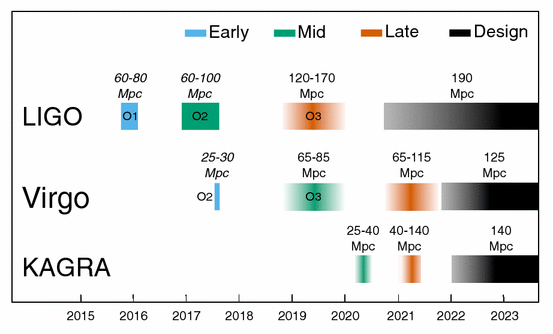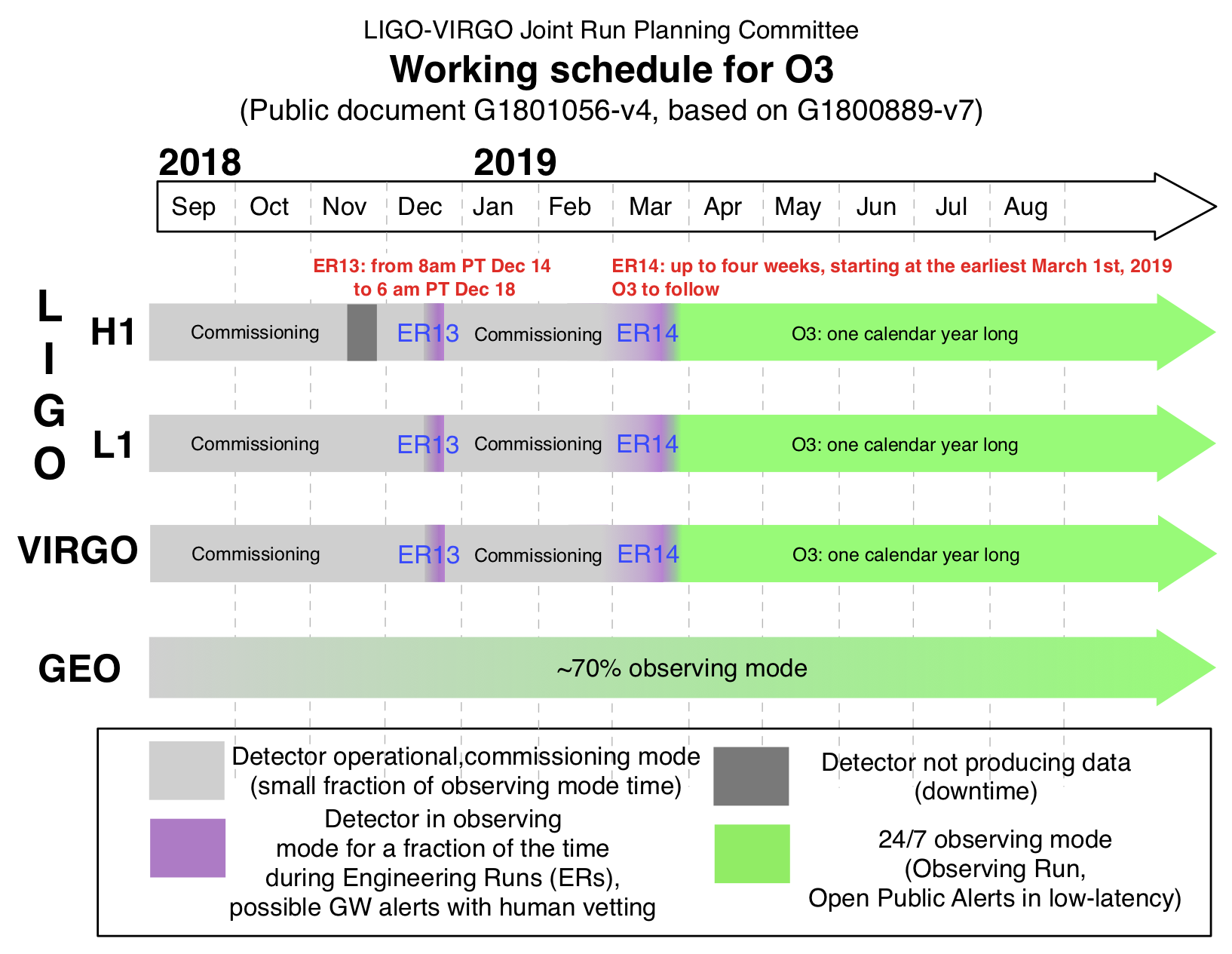Observing Capabilities¶
This section summarizes the observing capabilities of the global gravitational-wave detector network as of late 2018. This as a quick reference to the anticipated commissioning and observing schedule, sensitivity to gravitational-wave transients, and sky localization accuracy, as described in the following external documents:
- White Paper [1] on gravitational-wave data analysis and astrophysics
- Living Review [2] on prospects for observing and localizing gravitational-wave transients with Advanced LIGO, Advanced Virgo, and KAGRA
- Working Plan Towards O3 [3]
Timeline¶
The gravitational-wave observing schedules is divided into Observing Runs, epochs of months to years of operation at fixed sensitivity; down time for construction and commissioning, and transitional Engineering Runs between commissioning and observing runs. The long-term observing schedule is shown below.

Engineering Run 13 (ER13) is scheduled to start 2018-12-14 16:00 UTC and end 2018-12-18 14:00 UTC. Engineering Run 14 (ER14) is scheduled not before March 2019 for around 4 weeks and will transition without interruption to Observing Run 3 (O3).
During O3, we expect that all three detectors will observe continuously and without significant interruptions for one year. It is possible that the Japanese KAGRA detector may come online and become part of the joint gravitational-wave analysis at some point during O3. The near-term observing schedule is shown below, reproduced from [3].

Important
During both Engineering Runs, the detector configuration and analysis software will be changing frequently. We will send public alerts only for highly confident and scientifically significant events and with longer than normal latency. However, at the transition to O3 occurs, we will switch to routine low-latency data analysis and sending public alerts for all significant gravitational-wave events.
Sensitivity and Localization Accuracy¶
The following O3 projections are adapted from the Living Review [2] on prospects for observing and localizing gravitational-wave transients with Advanced LIGO, Advanced Virgo, and KAGRA. The range (luminosity distance of detectable sources, averaged over sky position and source orientation) given the detectors’ anticipated sensitivity are listed in the table below.
| Detector | BNS Range (Mpc) | Burst Range (Mpc) |
|---|---|---|
| LIGO | 120–170 | 75–90 |
| Virgo | 65–85 | 40–50 |
| Kagra | 8–25 |
We expect 1–10 BNS events over the course of O3. For BNS events, the median localization accuracy of in terms of the 90% credible area will be 120–180 deg². 12–21% of BNS mergers will be localized to less than 20 deg².
Event Rates¶
See the rates presentation from recent Town Hall meeting for LIGO and Virgo’s most current estimates of astrophysical rates of compact binary mergers.
| [1] | LIGO Scientific Collaboration & Virgo Collaboration 2018, The LSC-Virgo White Paper on Gravitational Wave Data Analysis and Astrophysics, LIGO Document T1800058-v1. https://dcc.ligo.org/LIGO-T1800058/public |
| [2] | (1, 2) Abbott, B. P., Abbott, R., Abbott, T. D., et al. 2018, Living Rev. Rel., 21, 3. https://doi.org/10.1007/s41114-018-0012-9 |
| [3] | (1, 2) LIGO Scientific Collaboration & Virgo Collaboration 2018, LIGO-Virgo Working Plan Towards O3, LIGO Document G1801056-v4. https://dcc.ligo.org/LIGO-G1801056/public |
